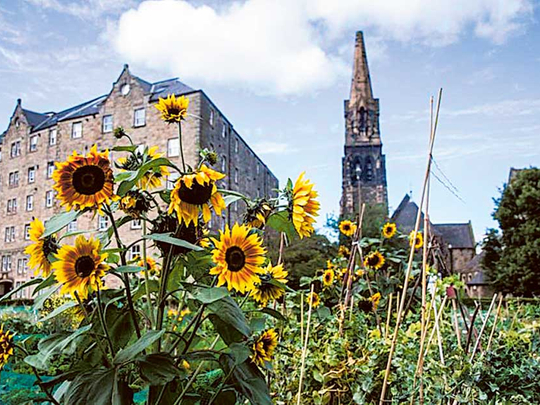
Edinburgh: On a two acre patch of land in north Edinburgh’s Leith neighborhood, Evie Murray walks with pride between plots of carefully tended flowers and vegetables.
“This area used to be used by drug addicts or prostitutes,” she said. “It was full of rubbish: syringes, condom wrappers.”
This is ‘Crops in Pots’, a community initiative in the Scottish capital which has seen hundreds of local residents planting marrows, potatoes, beans, chard, apples, gooseberries, and even a walnut tree.
It is one example of a quiet but significant wave of land reform that is changing the dynamic of property ownership in Scotland.
Scotland has the least equitable property ownership in western Europe, with half of the country’s land owned by fewer than 500 people.
Community ownership
In 2013, the Scottish National Party (SNP), which runs the devolved government in Edinburgh, pledged radical land reform, setting a target of one million acres of land in community ownership by 2020.
The move came amid growing tension over the dominance of large, often absent, land-owners whose hold over the country dates back to an era when Scotland was a largely agricultural nation run by the wealthy gentry.
The amount of land bought by communities from private landowners has now surpassed half a million acres, says the Scottish government.
As part of its reforms, the government more than tripled its contributions to the Scottish land fund to help communities by land, from £3 million pounds to £10 million pounds per year.
In March 2016, the SNP government also passed the Land Reform Act which gave communities the power to force the sale of land if they prove it could further “sustainable development.”
Long litigation
One of the largest community buy-outs unfolded last December on the Pairc Estate on the Isle of Lewis in the Outer Hebrides when 12 years of litigation ended in the sale of 28,000 acres of land to the local community for £500,000.
However, campaigners say that not only are the reforms long overdue but the law still doesn’t go far enough.
According to Scottish land reform minister, Roseanna Cunningham, the biggest obstacle to change is the extent to which communities themselves feel included in the process.
In an interview after announcing the 500,000 acre milestone last week, Cunningham said communities often only express an interest in buying land after it is put up for sale — and by then it is often too late.
She conceded there were limits to the new legislation: “There are big tracts of land that will probably never come up for sale ... it’s handed down through generations.” Much of Scotland’s land inequality can be traced back to a system of aristocratic inheritance, coupled with a violent campaign in the 1800s to clear small farmers and residents off their land to make way for large sheep holdings.
“There is a lot to do but you’re not in a position where you can just wave a magic wand and change the whole land ownership system overnight,” Cunningham said.
“Scotland has the weirdest pattern of land ownership in the developed world and I don’t think anyone’s arguing about that,” said Lesley Riddoch, a coordinator of ‘Our Land’, a month-long festival of talks and meetings focused on land.
Riddoch was one of the original trustees of the Inner Hebrides island of Eigg.
A beacon for many of the land campaigners, it was bought by the local community for 1.5 million pounds in 1997, and became the first solar, wind and water-powered electricity grid in the world.
“We have to keep banging on about this. Land in Scotland is probably more unaffordable and more unavailable than any country in Europe,” she said.
Lorne MacLeod, chairman of Community Land Scotland, said putting land in the hands of communities allows them to use the land in the way that’s most beneficial to them.
“People are being put in charge of their own destiny in terms of taking control of the land around them,” said MacLeod, whose organisation represents 69 communities across Scotland, including around 40 which have successfully bought out land.
Some communities had built new harbours, erected wind turbines and even created an 18-hole golf course - profits from which will be reinvested in the local area.
Community area
Evie Murray, 39, has spent her life in Leith. A former drug addiction worker, she was made redundant shortly after the 2008 economic crash.
She found raising children and foster children in the city difficult, she said, and finding safe outdoor play areas in a neighborhood fraught with social problems was a challenge.
It was this that gave her the idea to create a community area for other parents and neighbours.
Murray approached the local council in 2013 and won permission to use the area at the edge of Leith Links Park - even if the lease remains a rolling, short-term one.
Now, at least 100 people tend the soil plots regularly, according to Murray, with an eclectic and intergenerational mix of people involved.
The community is now attempting to negotiate another lease for a small building on the site, to turn into a cafe using local produce.
“Land and having the access to it is hugely important for people’s health,” said Murray, gesturing towards the gardeners chatting and laughing by their plots. “It’s hard to quantify the impact it’s having but you can see it with your eyes.”













